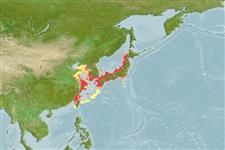Common names from other countries
Environment: milieu / climate zone / depth range / distribution range
Écologie
marin; eau douce; saumâtre; amphidrome; profondeur 30 - ? m (Ref. 10943). Temperate; 34°N - 17°S
Northwest Pacific: Yellow Sea, Pohai Sea, Japan Sea, and the Pacific coast of Japan, extending north to Sakhalin and to Preobrazheniye Bight and Vladivostok in the Gulf of Peter the Great. Recorded from the lower part of the Yangtze River in China. Occurrence of this species south to the Ryukyu Islands and Taiwan needs verification.
Length at first maturity / Taille / Poids / Âge
Maturity: Lm ?, range 17 - ? cm
Max length : 40.0 cm TL mâle / non sexé; (Ref. 637)
Description synthétique
Clés d'identification | Morphologie | Morphométrie
Épines dorsales (Total) : 0; Rayons mous dorsaux (Total) : 14 - 18; Épines anales: 0; Rayons mous anaux: 15 - 18; Vertèbres: 59 - 63. Anterior branch of its preorbital canal curved forward at an angle of about 90°. Predorsal scales 66-81; vertebrae 59-63; pectoral fin rays 12-14, usually 13. Lower jaw shorter than head length.
Common in inshore waters. Occurs in the lower part of the Yangtze River in China (Ref. 10943). Forms small schools and feed mainly on zooplankton. Meat delicious. Also caught with dip nets. Used in Chinese medicine (Ref. 12166).
Life cycle and mating behavior
Maturities | Reproduction | Spawnings | Egg(s) | Fecundities | Larves
Collette, B.B. and J. Su, 1986. The halfbeaks (Pisces, Beloniformes, Hemiramphidae) of the Far East. Proc. Acad. Nat. Sci. Philadelphia 138(1):250-301. (Ref. 10943)
Statut dans la liste rouge de l'IUCN (Ref. 130435)
CITES (Ref. 128078)
Not Evaluated
Menace pour l'homme
Harmless
Utilisations par l'homme
Pêcheries: commercial
Outils
Articles particuliers
Télécharger en XML
Sources Internet
Estimates based on models
Preferred temperature (Ref.
115969): 6.9 - 21.7, mean 18.4 (based on 8 cells).
Phylogenetic diversity index (Ref.
82804): PD
50 = 0.5000 [Uniqueness, from 0.5 = low to 2.0 = high].
Bayesian length-weight: a=0.00209 (0.00116 - 0.00377), b=3.07 (2.91 - 3.23), in cm Total Length, based on LWR estimates for this species & Genus-body shape (Ref.
93245).
Niveau trophique (Ref.
69278): 3.4 ±0.45 se; based on food items.
Résilience (Ref.
120179): Milieu, temps minimum de doublement de population : 1,4 à 4,4 années (Assuming tm=2).
Fishing Vulnerability (Ref.
59153): Low to moderate vulnerability (30 of 100).
Climate Vulnerability (Ref.
125649): Very high vulnerability (76 of 100).
